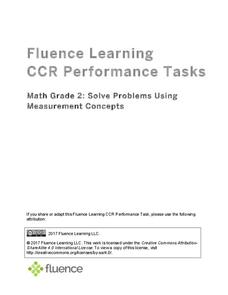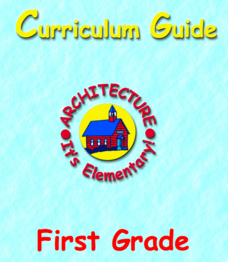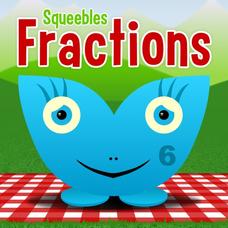Curated OER
Parallelism (Unit 7-3200)
How do you create parallel structure? Here, the first section details parallelism, providing many examples. The next two sections provide your class with practice opportunities. The first one requires learners to identify the sentences...
Fluence Learning
Solve Problems Using Measurement Concepts
Young mathematicians demonstrate what they know about measurement with a four-task assessment that focuses on estimation, length, and inches.
Fluence Learning
Construct Viable Arguments About Adding Fractions
Test mathematicians' knowledge of adding fractions with a brief assessment that challenges them to play teacher while correcting a peer's work. Scholars examine Carl's mathematical response, identify where he went wrong,...
Curated OER
Vocabulary Cards 2nd Grade A-L
Use a set of math vocabulary cards to enrich your second graders' knowledge. Whether you bring the cards to a math center or put them on a word wall, this resource will help even your struggling math learners with basic definitions and...
New York City Department of Education
How I Roll
There's a high likelihood for learner success in this set of probability problems and activities. From support activities that walk learners through joint and compound probabilities through the cumulative activity of planning to win...
Common Core Sheets
Using Order of Operations
With two versions and an answer key, this order of operations worksheet is easily accessible for most learners to practice their skills.
EngageNY
Volume of Composite Solids
Take finding volume of 3-D figures to the next level. In the 22nd lesson of the series, learners find the volume of composite solids. The lesson the asks them to deconstruct the composites into familiar figures and use volume formulas.
Curated OER
Geometry - Angles Overview
Learners address 14 questions that include naming all pairs of opposite and supplementary angles for sets of intersecting lines and then, finding the measure of the unknown angle. They determine the measure of the angle that is...
Curated OER
Teddies
Here's a really cute lesson that utilizes all of your children's teddy bears. Each pupil brings their favorite teddy bear to school. The lesson has many wonderful suggestions for learning activities that can be done with the bears once...
American Institute of Architects
Architecture: It's Elementary!—First Grade
Build an interest and appreciation for architecture in your young learners with this fun 10-lesson art unit. Engaging children in using their five senses, the class first observes the environment around them, paying...
Curated OER
Avoiding Run-On Sentences (I)
Eliminate run-on sentences! This practice opportunity highlights run-on sentence errors and how to fix them. Examples are shown, and learners are given two options: using semi-colons or commas and coordinating conjunctions. Help polish...
McGraw Hill
Metric Units of Weight and Volume
Getting the right measurements can save a lot of time and money in the real world. Learners are introduced to unit conversion and how to accurately go from one unit to another. The first pages are notes and then the packet finishes with...
New York City Department of Education
Dance and Text
Use texts and dances to teach inequalities and equations. A sixth-grade unit covers using variables in equations and inequalities to solve problems. Learners show what they know at the end of the unit using two performance tasks, one...
NWT Literacy Council
Readers Theatre Scripts
Engage and entertain young learners with this collection of readers theatre activities. With over 25 different scripts, a wide range of topics are covered from simple counting and rhyming exercises to adaptions of popular children's...
Curated OER
Do you have the time?
A very simple worksheet, this handout includes a model conversation and 12 different time expressions such as "It's five after (two)" and "It's quarter to (three)". After studying the model conversation and the time expressions provided,...
British Council
Unit 6: Enquiries
So many questions! How do people in the business world answer them? Young communicators demonstrate their understanding of correct grammar in the sixth of nine lessons focused on developing career skills. Types of questions range from...
K5 Learning
Grace Darling
Scholars read about a courageous young girl named Grace and her fearless act to save sailors at sea. Then, test their reading comprehension by way of four short answer questions.
K5 Learning
Race Cars
Do you ever get nervous before a big event? A pair of race cars discuss their nerves before tomorrow's race in a reading activity that includes five comprehension questions.
K5 Learning
One of Aesop's Fables
It's one thing to have an idea, but someone has to put it into action! Young pupils read a rendition of Aesop's fable of the mice in the council before answering four questions about details from the text.
Key Stage Fun
Squeebles Fractions
We are not exactly sure what a Squeeble is, but apparently they love cake and fractions, and your little bakers-turned-mathematicians will also. This app focuses on the basics of fractions including modeling fractions, equivalent...
Math Worksheets Land
Pie or Circle Graphs Problems - Independent Practice Worksheet
Third graders take a set of data and turn it into a pie graph with an independent activity. Containing 10 sets of data, the resource reinforced data analysis skills that pupils can use throughout a graphing unit.
K5 Learning
What Police and Detectives Do
What do police and detectives do to keep their community safe? Six short-answer questions make up a activity designed to reinforce reading comprehensions skills while providing information about police officers and detectives.
K5 Learning
Survival in the Wild
How do animals survive in the wild? Read about the different adaptations such as camouflage and self-protection that animals use to survive.
K5 Learning
Luke, Jay and Zach's Winning Game
There's nothing like the thrill of winning the big game! Fourth graders practice reading comprehension skills with a short story and series of questions.























